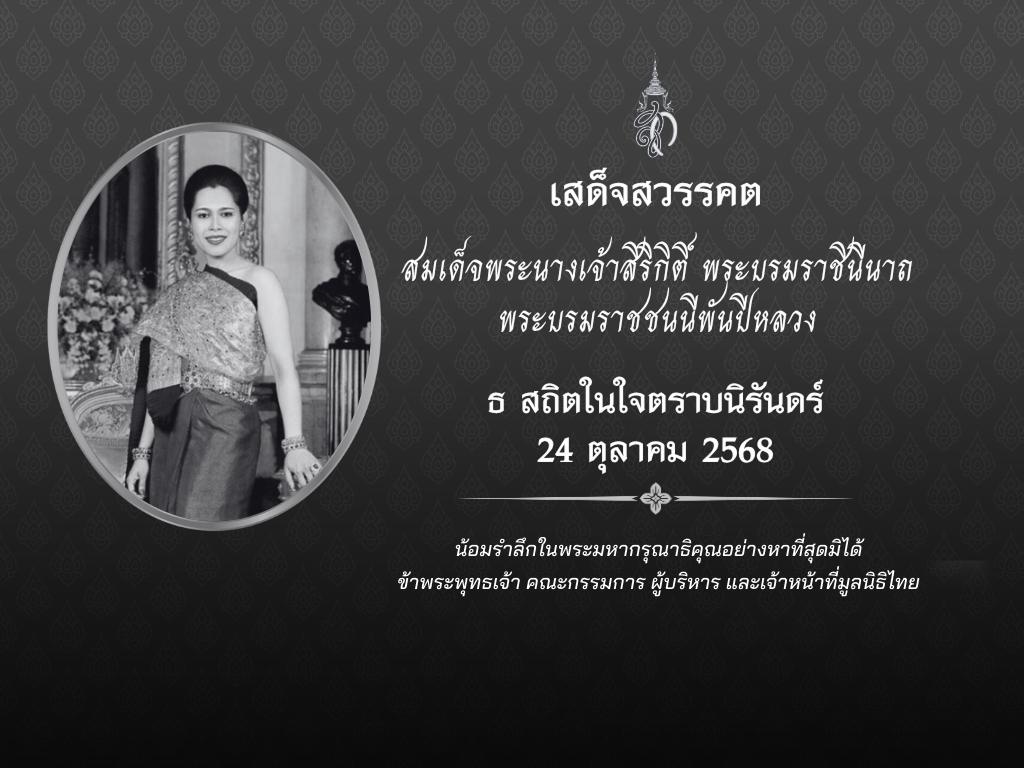Thai traditional clothing or chut thai (ชุดไทย) reflects Thai values and its way of life, a cultural heritage passed down through generations. Despite changes in fashion and lifestyle, chut thai continues toplay an important role in Thai society. It is still a common sight at ceremonies, national events and, with its modern adaptation, even in daily life. This article explores what chut thai truly is, how it has developed over time, and why it still matters today.
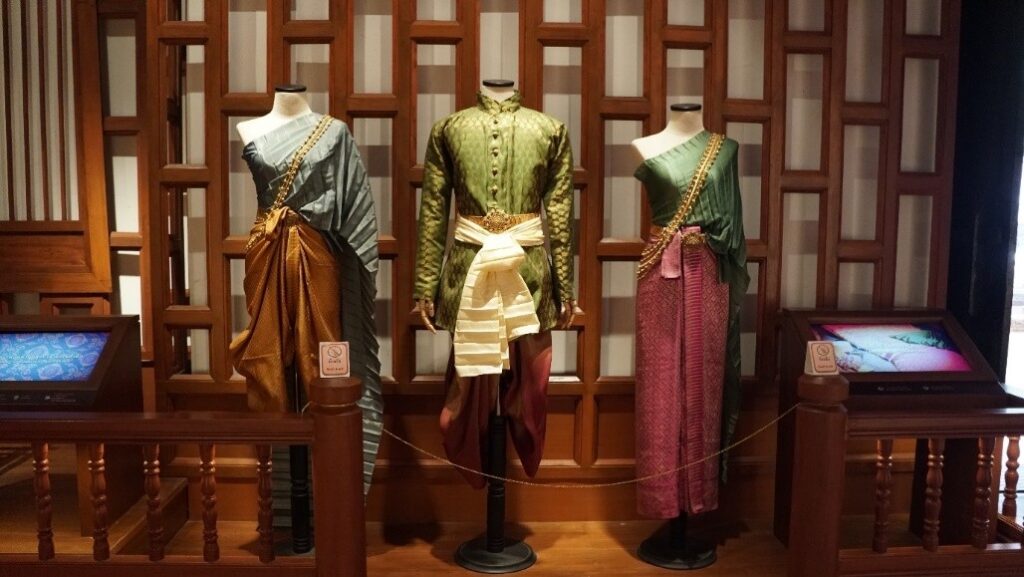
Photo credit: Wikipedia
What is Chut Thai?
Essentially, chut thai or Thai traditional clothing refers to a variety of clothing styles reflecting the culture, history, and diversity of the Thai people. To fully understand what counts as chut thai, it is helpful to view it from multiple perspectives.
In its most general sense, chut thai is defined as the traditional clothing worn by Thai people in the past. This ranges from the simple, practical outfits of ordinary people to the more intricate court attire reserved for royalty. In a broader sense, the term can also extend to the diverse traditional clothing of different ethnic groups across Thailand, reflecting local identities, customs, and climates, enriching the broad category of Thai traditional clothing.

Chut Thai
Photo credit: 88 Image
Another widely recognized interpretation of the term chut thai are the formalized styles developed in the 20th century. For women, this includes eight official styles known as chut thai phraratchaniyom (ชุดไทยพระราชนิยม), roughlymeaning “royally endorsed Thai dresses” as they were introduced under the guidance of Her Majesty Queen Sirikit The Queen Mother. Each style is suited to different levels of formality and occasions.

Photo credit: Finale Weddingstudio
For men, a set of formal garments known as suea thai phraratchathan (เสื้อไทยพระราชทาน), meaning “royally bestowed Thai shirt,” was also introduced. These formalized styles are now considered national clothing and are often worn during important events.
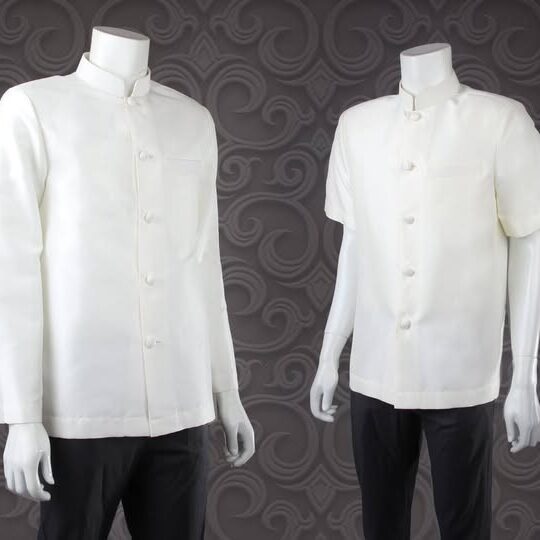
Photo credit: Phahurat
Another dimension of chut thai are the modern adaptations and alternatives inspired by traditional designs. Many contemporary designers draw inspiration from the traditional elements, patterns, and fabrics of chut thai to create updated versions that maintain Thai cultural roots while aligning with modern lifestyles.
Some Important Elements of Chut Thai
Traditional Thai clothing typically consists of two main parts: a lower garment and an upper garment. These two parts are encapsulated in the term nung hom (นุ่งห่ม), meaning “to cover, or wear.” While some elements may vary across time, gender, and region, there are several key elements commonly seen in chut thai for both men and women.

Photo credit: Pinterest
Lower Garments
The lower garments, which are paired with upper garments for both men and women, comprise two significant types:
Pha Nung (ผ้านุ่ง)
Pha nung is a rectangular piece of cloth wrapped around the lower body, similar to a sarong or a long skirt. The patterns and fabric types often reflect the wearer’s social status. Ordinary people typically wore plain, simply woven fabrics while those of higher social status wore finer textiles crafted with more intricate techniques. A notable type of pha nung is sinh (ซิ่น), which is a more decorative and elaborately woven piece of fabric commonly worn by women, often incorporating regional patterns and designs.

Photo credit: Pinterest
Chong Kraben (โจงกระเบน)
Chong kraben is essentially a pha nung that is wrapped and twisted, with one end passed between the legs and tucked at the back of the waist, resembling loose pants. This style was more practical and suitable for everyday wear or activities that required greater movement.

Photo credit: SIWALAI
Garments for Men
Raj Pattan (ชุดราชปะแตน)
The name raj pattan comes from a blend of the word raj, meaning “royal,” and the English word “pattern,” adapted into Thai pronunciation. This formal outfit for men was introduced during the reign of King Rama V (1868-1910). It consists of a white Nehru jacket with five buttons, traditionally worn with a chong kraben, knee-length socks, and clothing shoes. Today, it can also be paired with long trousers and remains a common choice for national events and formal ceremonies.

Photo credit: Praew)

Photo credit: Sanook
Suea (เสื้อ)
Suea, or shirts, come in a variety of styles depending on the occasion. During the reign of King Rama IX (1946-2016), three official designs adapted from raj pattan were introduced as formal wear for men. These shirts are characterized by a high-standing collar and a button-down front. Short-sleeved versions are suitable for daytime events, while the long-sleeved version is preferred for evening. For formal ceremonies, long sleeves are typically worn with a sash. Shirts are commonly paired with a chong kraben, or Western-style suit trousers for a more modern look.
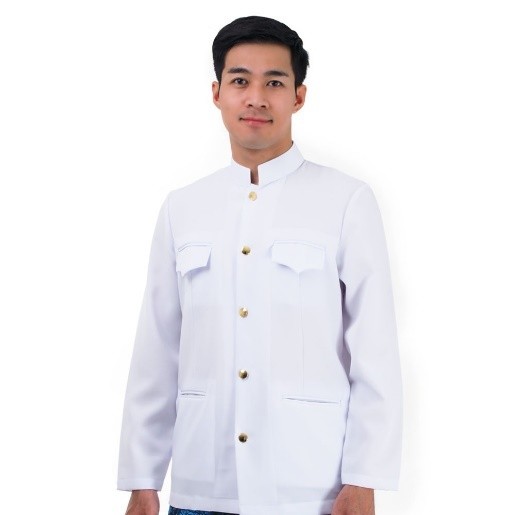
Photo credit: Princess of Asia
Upper Garments for Women
Pha Biang or Sabai (ผ้าเบี่ยง/สไบ)
This is a long piece of fabric draped diagonally over one shoulder with its end dropping behind the back. It is one of the most iconic features of traditional women’s clothing, often worn with either a sinh or a chong kraben. While in the past, a sabai could be worn on its own, it is now more commonly layered over a blouse or a shirt for modesty and formality.
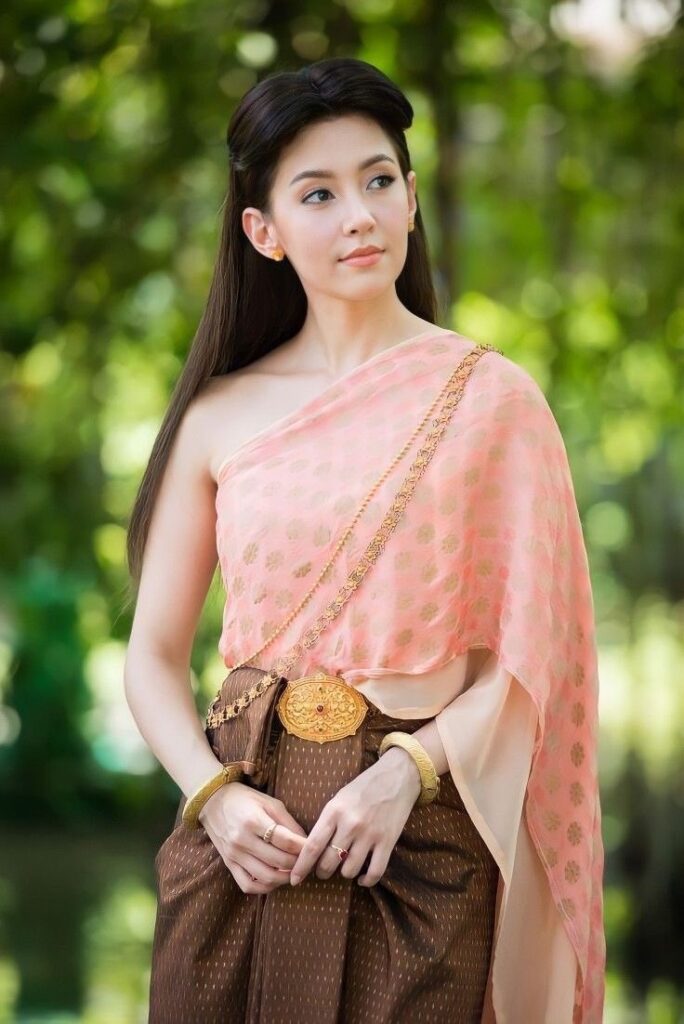
Photo credit: Pinterest
Suea (เสื้อ)
In more formal or modern styles, a blouse or fitted shirt is worn. Long-sleeved blouses, lace blouses and puff-sleeved tops can be paired with a sabai draped over the shoulder.

Photo credit: Pinterest
Chut Thai Phraratchaniyom

Photo credit: Chobmai
Chut thai phraratchaniyom refers to a collection of eight official styles of traditional Thai dresses for women, developed in the 20th century under royal patronage. Each style, named after royal villas or throne halls, varies in terms of formality and is designed for specific occasions. Below are the key distinctions between the styles:
- Thai Ruean Ton (ไทยเรือนต้น): A relatively simple style suitable for informal gatherings and casual events. It is the least formal among all of the official styles.
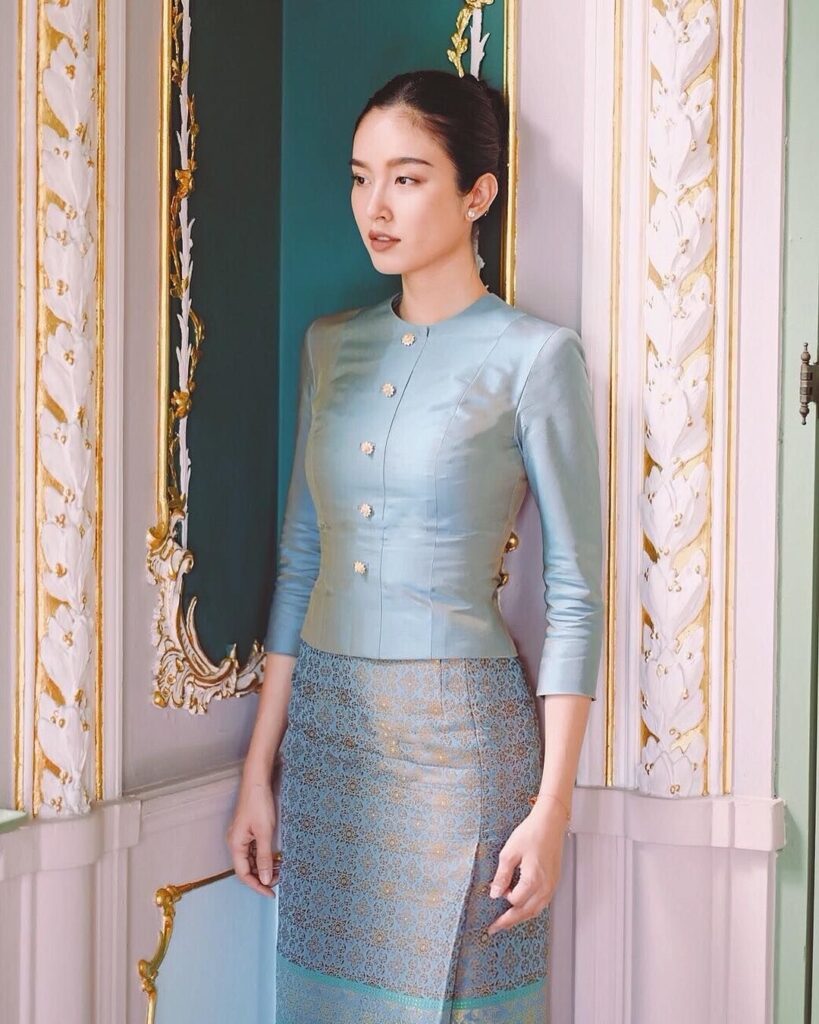
Photo credit: Pinterest
- Thai Chitralada (ไทยจิตรลดา): A more formal version of Thai Ruean Ton, appropriate for daytime ceremonies and official daytime functions.
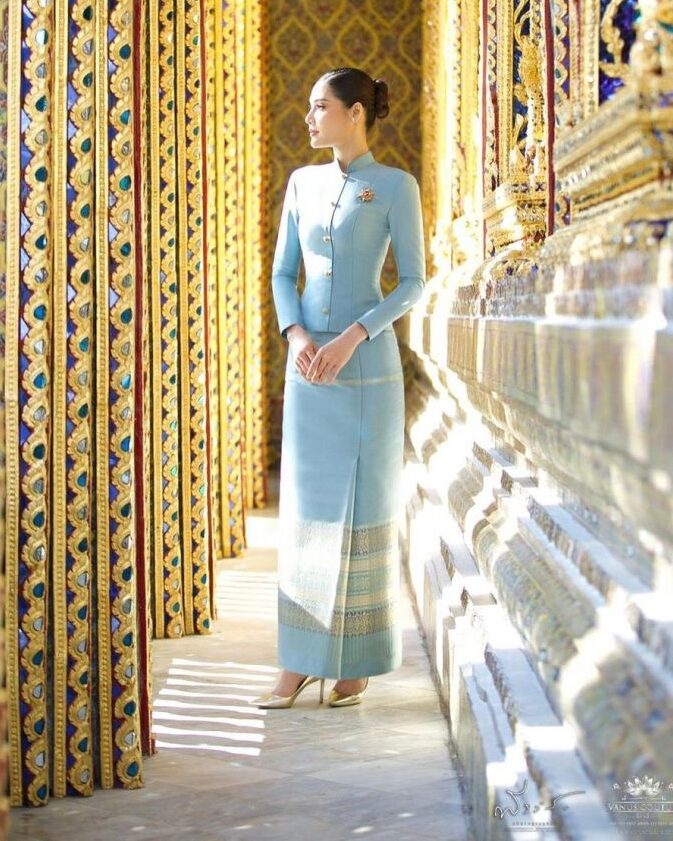
Photo credit: Praew
- Thai Amarin (ไทยอมรินทร์): Formal evening wear suitable for receptions, plays, or royal ceremonies. This style is worn without a belt. The style is similar to Thai Chitralada dress, but for Thai Amarin, the fabric of the lower garment must be a silk brocade .
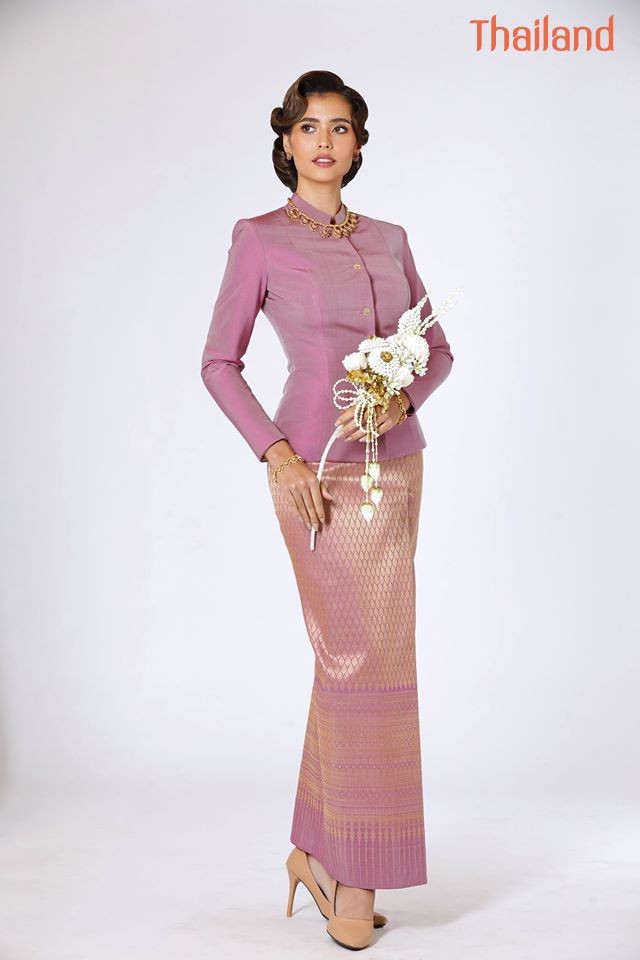
Photo credit: Pinterest
- Thai Boromphiman (ไทยบรมพิมาน): A formal evening dress with long sleeves, a standing collar and a belt, suitable for highly formal and semi-formal occasions such as royal banquets and official evening events.

Photo credit: Deep Love Wedding
- Thai Chakri (ไทยจักรี): Worn for evening events, weddings, or semi-formal receptions, this style features a one-shoulder sabai drape, leaving one shoulder exposed, making it elegant and graceful while less formal than the full ceremonial styles.
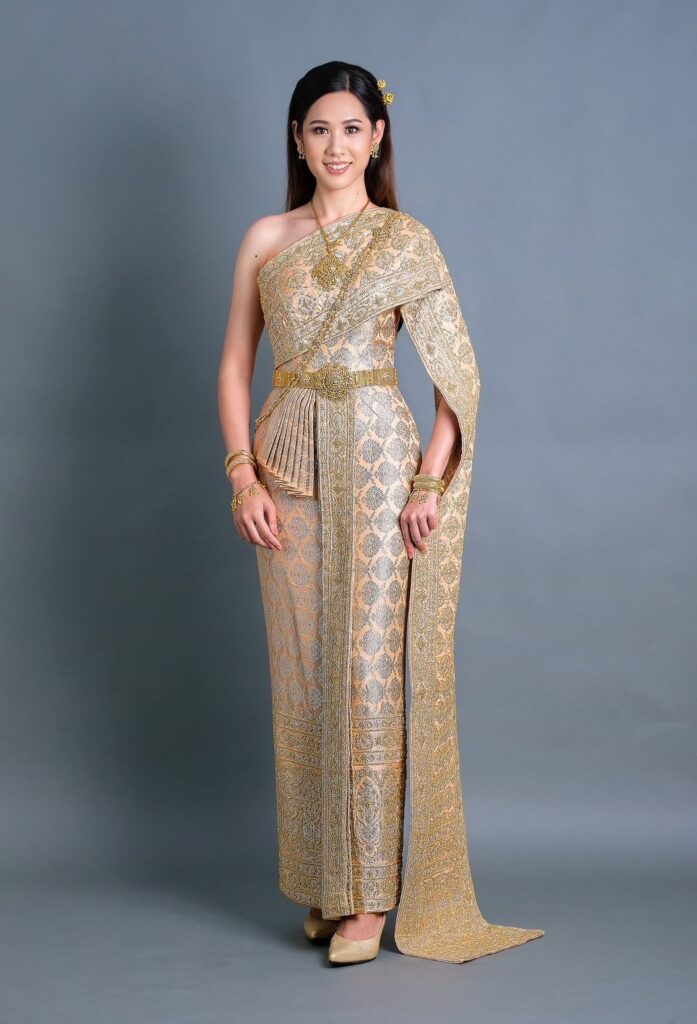
Photo credit: Pinterest
- Thai Chakrapat (ไทยจักรพรรดิ): This style is similar to Thai Chakri but is considered even more elegant. It features a luxurious silk brocade with two layers of sabai. The dress is richly adorned with accessories, suitable for occasions requiring full formal attire.
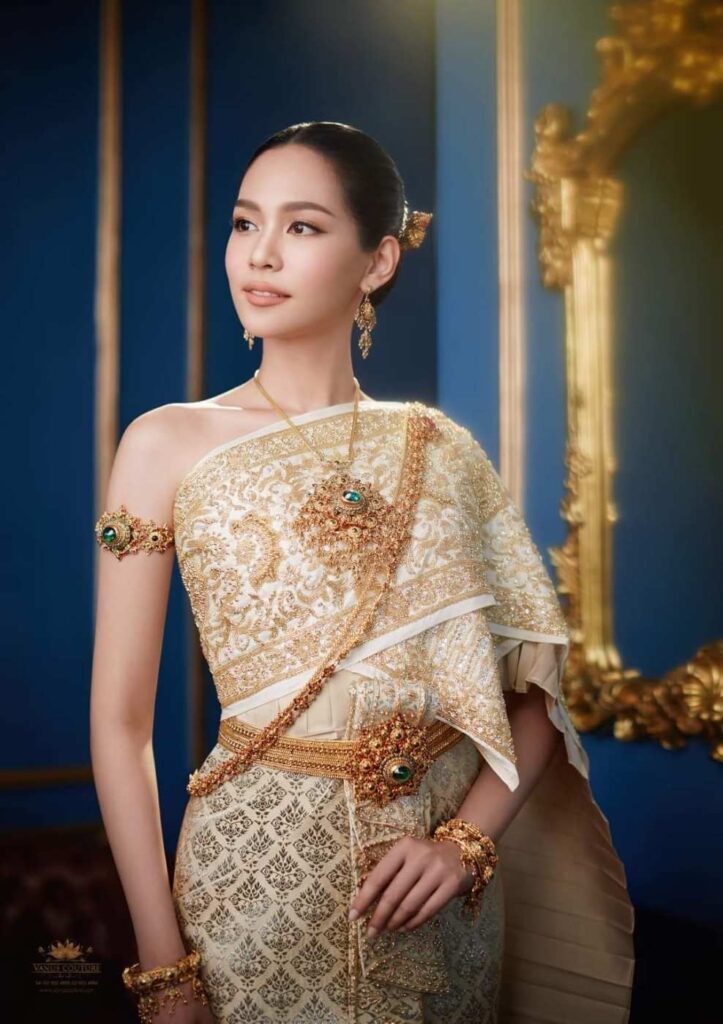
Photo credit: Pinterest
- Thai Dusit (ไทยดุสิต): A sleeveless evening dress with a low, wide neckline and back. It is also appropriate for full-dress ceremonies and evening events, especially during warmer weather.

Photo credit: Line Today
- Thai Siwalai (ไทยศิวาลัย): This is a vey formal style. It is suitable for evening events, banquets, weddings, and royal ceremonies. With its layered components, it is ideal for cooler weather.

Photo credit: Praew
History and Evolution of Thai Traditional Clothing
In ancient times, Thai clothing emphasized practicality with both genders typically wearing two main pieces. The upper garment was often a sabai or a piece of fabric wrapped around the upper body, while the lower garment was a chong kraben or pha nung. Shirts and trousers were rare and mostly reserved for specific occasions or higher social classes. However, chut thai has evolved over centuries, reflecting the country’s cultural, social, and political transformations.
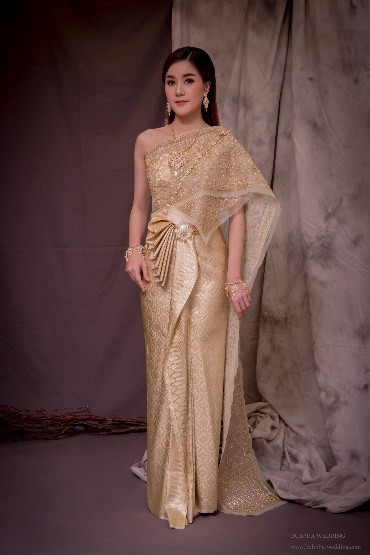
Photo credit: Bubpha Wedding
Sukhothai Period (13th-15th Century)
Due to limited historical records, much of what is known about chut thai during the Sukhothai era comes from stone carvings and sculptures. These suggest that men often wore a chong kraben without shirts, while women wore a chong kraben or pha nung paired with a cloth wrapped around the upper body. The style was simple, suitable for the practical needs of daily life and the tropical climate.

Photo credit: Pinterest
Ayutthaya Period (1351-1767)
During the Ayutthaya period, while male commoners often went shirtless, officials and nobles sometimes wore a khrui (ครุย), a knee-length, open-front muslin robe with wide sleeves, over their lower garment. Women wore a pleated sinh or chong kraben with a sabai, either on its own or draped over a shirt. Clothing in this era began to reflect social status more distinctly, with higher classes wearing finer fabrics and more elaborate designs. Trousers, known as sanap phlao (สนับเพลา), or knee-length pants, were also introduced around this time.

Photo credit: Pinterest
Rattanakosin Era (1782-present)
According to Paothong Thongchua, a Thai textile and history expert, traditional Thai attire during the early Rattanakosin period — from the reigns of Rama I to Rama III (1782-1851) — closely resembled that of the late Ayutthaya era. A shift began during the reign of King Rama IV (1851-1868) who initiated reforms, including encouraging all court officials to wear shirts during royal audiences in an attempt to modernize the nation. The transformation became even more pronounced in the reign of King Rama V (1868-1910), as increased contact with the West brought significant changes to court fashion. The raj pattan outfit was introduced for men. Noblewomen began wearing lace blouses and puffed sleeves layered with a smaller sabai to complement the Western-style blouse. Chong kraben gradually replaced sinh during this period. As Western influence deepened in the reign of King Rama VI (1910-1925), women’s fashion further evolved. The Gatsby-style blouse, chokers, and headbands became popular, while sinh returned, replacing chong kraben once again. A shorter sinh and Western-style full clothing also became fashionable. Men continued to wear the raj pattan, paired with silk trousers instead of a chong kraben.
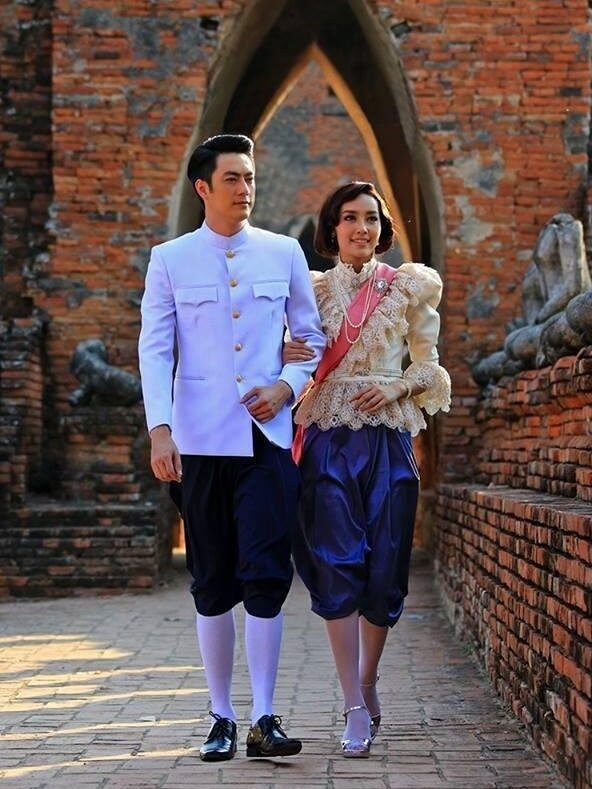
Photo credit: Steemit
In the 1960s, Her Majesty Queen Sirikit The Queen Mother recognized the need to formalize traditional Thai attire for official functions and national representation on the global stage. Her Majesty commissioned research to revive and redesign Thai traditional clothing, emphasizing the use of Thai local textiles, ensuring the designs were suitable for the climate, appropriate for various occasions, and representative of Thai identity. As a result, eight official styles of chut thai for women were introduced and popularized at the international level during Their Majesties’ state visits to Europe and the United States. As for men, three styles of formalized outfits called suea phraratchathan were bestowed in 1979.

the Queen Mother
Photo credit: MThai
Contemporary Relevance and Revival
In recent years, many Thai designers have embraced the elegance and uniqueness of chut thai, adapting its textiles, patterns and distinctive features into more contemporary styles known as chut thai prayuk (ชุดไทยประยุกต์),making them more suitable for modern lifestyles and evolving fashion trends. Thai celebrities and members of the royal family have also played a key role in promoting traditional and local textiles by wearing them at both national and international events. Cultural campaigns such as Thai Heritage Conservation have further encouraged the public to wear traditional clothing.

Photo credit: Praewwedding
Among younger generations, chut thai has become increasingly popular for pre-wedding photoshoots and cultural outings, especially at famous temples. These photos, often shared on social media, have sparked a wider trend, attracting even foreign tourists to rent traditional outfits during their visits. This growing interest reflects a sense of national pride and cultural appreciation.
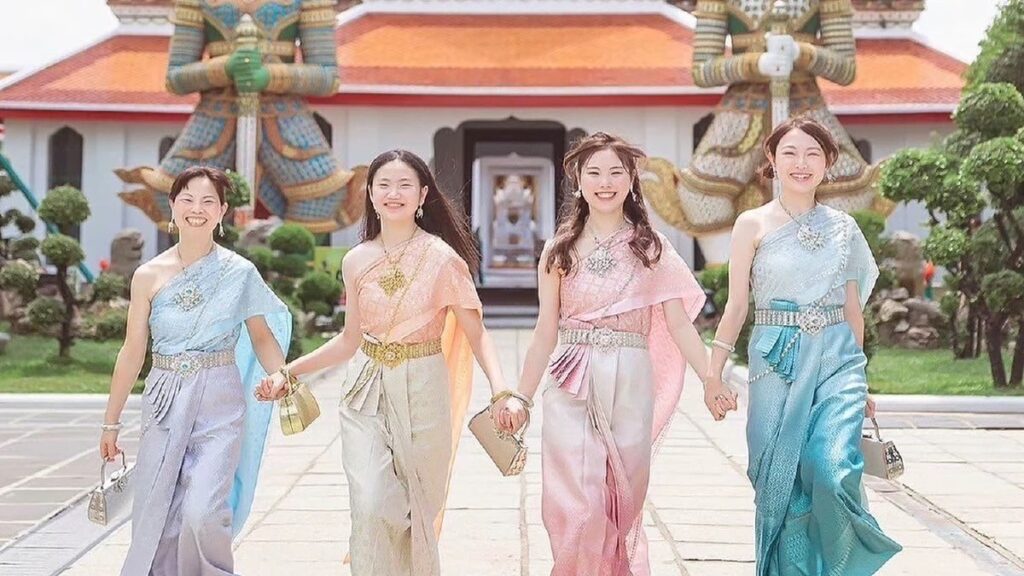
Photo credit: Ticket2attraction
Cultural and Symbolic Significance
Chut thai and its evolution is a great example of how Thai people have adapted their clothing to suit both the climate and changing times. What began as practical everyday wear has grown into a symbol of national identity. Chut thai embodies core Thai values — grace, modesty, and elegance. Its beauty lies in balance: the textiles are carefully woven, the patterns are intricate, and the accessories are thoughtfully chosen, creating a refined look without any element outshining the other. Such elegant traditional clothing also plays a key role in expressing Thai identity, pride, and cultural richness, especially during royal ceremonies, state functions, and religious events where many participants proudly wear chut thai. Furthermore, it is still worn in various places such as schools, universities, or government offices on designated traditional clothing days, reinforcing a sense of social unity.
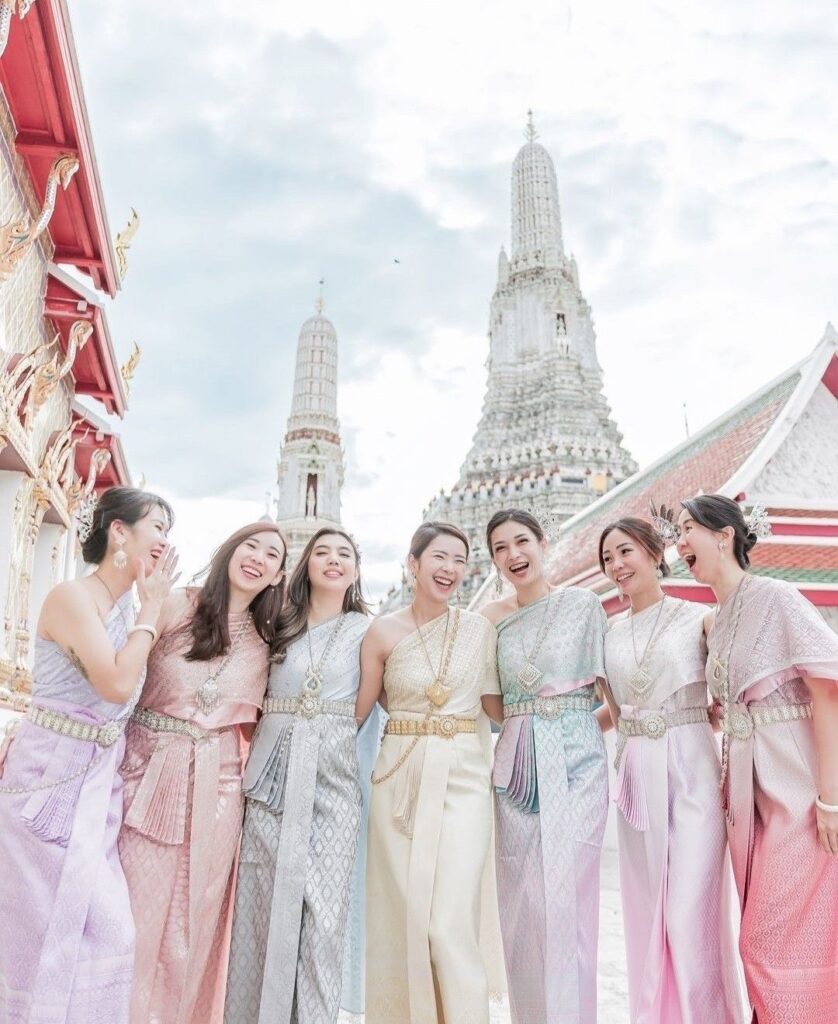
Chut Thai
Photo credit: Pinterest
Regional variations further highlight the diversity within Thai culture. The North’s pha sinh (ผ้าซิ่น), the Northeast’s mat mee (มัดหมี่) patterns, and the South’s distinct batik-patterned sarong all display the diversity of local identities existing in harmony within the broader Thai cultural landscape.

Photo credit: patcharachat565

Photo credit: ตลาดเกษตรกรออนไลน์
Conclusion
Chut thai is much more than just traditional clothes. It is a symbol of Thai identity, craftsmanship, values and cultural pride. Understanding its history, from the early period of practicality to the modern adaptation, deepens our appreciation for Thai cultural identity and its values across time and region. For those visiting or exploring Thai culture, wearing chut thai respectfully at cultural landmarks or simply appreciating its beauty can enrich your experience, offering a deeper connection to Thai heritage and helping to keep this cultural treasure alive in today’s ever-changing world.

Photo credit: Pinterest
The story of chut thai is a colorful aspect of Thai culture and heritage. It reflects the values of grace, elegance, and modesty, as well as the talented craftsmanship that has endured through centuries of cultural change. Its continued presence shows the deep pride Thai people have in their rich heritage. Join us in exploring more stories of Thailand and the Thai people, as we take you on a journey to discover Thainess.
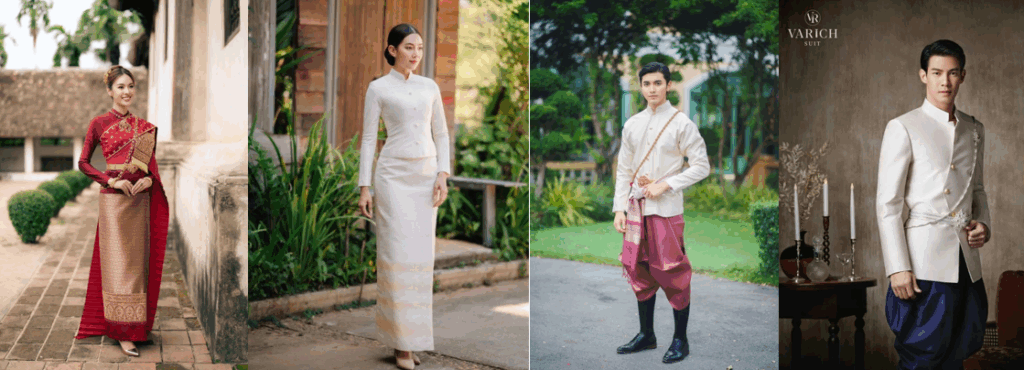
Photo credit: Pinterest
Sources
- https://kruwarut.com/?web=les04.3#:~:text=1.%20%E0%B8%AA%E0%B8%A1%E0%B8%B1%E0%B8%A2%E0%B8%AA%E0%B8%B8%E0%B9%82%E0%B8%82%E0%B8%97%E0%B8%B1%E0%B8%A2,%E0%B8%94%E0%B9%89%E0%B8%A7%E0%B8%A2%E0%B9%80%E0%B8%82%E0%B9%87%E0%B8%A1%E0%B8%82%E0%B8%B1%E0%B8%94%E0%B9%84%E0%B8%A1%E0%B9%88%E0%B8%AA%E0%B8%A7%E0%B8%A1%E0%B9%80%E0%B8%AA%E0%B8%B7%E0%B9%89%E0%B8%AD
- http://www.m-culture.in.th/album/196682/%E0%B8%A7%E0%B8%B1%E0%B8%92%E0%B8%99%E0%B8%98%E0%B8%A3%E0%B8%A3%E0%B8%A1%E0%B8%81%E0%B8%B2%E0%B8%A3%E0%B9%81%E0%B8%95%E0%B9%88%E0%B8%87%E0%B8%81%E0%B8%B2%E0%B8%A2
- https://ich-thailand.org/heritage/detail/65cdc4c33a1da799f48c8017
- https://qsds.go.th/newqssclei/%E0%B8%9B%E0%B8%A3%E0%B8%B0%E0%B8%A7%E0%B8%B1%E0%B8%95%E0%B8%B4-%E0%B8%8A%E0%B8%B8%E0%B8%94%E0%B9%84%E0%B8%97%E0%B8%A2%E0%B8%9E%E0%B8%A3%E0%B8%B0%E0%B8%A3%E0%B8%B2%E0%B8%8A%E0%B8%99%E0%B8%B4%E0%B8%A2/
- https://www.vogue.co.th/fashion/inspirations/article/majesticbrocadevogueaugust2020
- https://saranukromthai.or.th/oldchild/1514
- https://thailandinsider.com/everything-you-need-to-know-about-traditional-thai-clothinges/
- https://www.matichon.co.th/lifestyle/news_839539
- https://www.silpa-mag.com/culture/article_35511#google_vignette
- https://www.silpa-mag.com/history/article_28064
- https://www.silpa-mag.com/culture/article_15436
- https://crownproperty.or.th/%E0%B9%84%E0%B8%97%E0%B8%A2%E0%B8%9E%E0%B8%A3%E0%B8%B0%E0%B8%A3%E0%B8%B2%E0%B8%8A%E0%B8%99%E0%B8%B4%E0%B8%A2%E0%B8%A1
- https://www.thailandnow.in.th/arts-culture/chut-thai-every-thai-traditional-clothing-explained/
Author: Thanachporn Varapongsittikul


